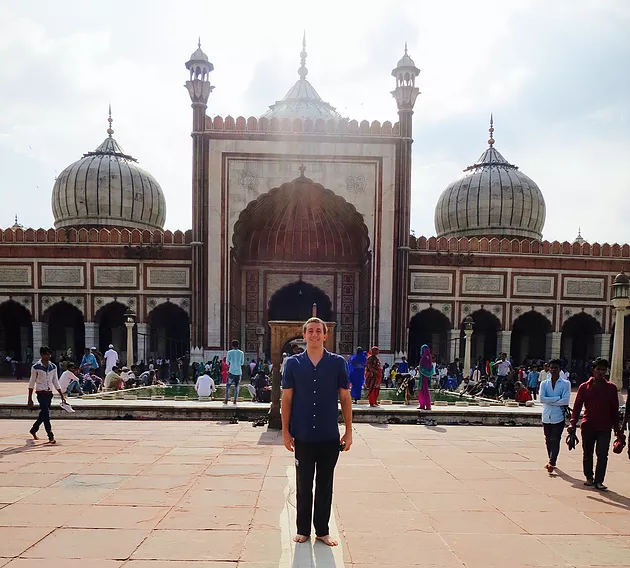
Before this trip, we thought of India as a monolith. But during our stay here, and especially this past week, we’ve come to appreciate the incredible diversity of people and culture of this massive country. There are 28 states in India, many with their own distinct flavors. For example, even though the official language of India is Hindi, many of the states speak different dialects and different languages altogether.
On Monday, we took tours of different religious sites throughout New Delhi. Knowing that India is predominately Hindu, it was interesting to see different religions practiced so closely. On our first tour, we took off our shoes and walked through an archway onto the courtyard of the largest Mosque in India, Jama Masjid. We were captivated by the sheer size of the chandelier, domes, minarets, and the staircase leading up to the Mosque. The sight of 10 foreigners fascinated the locals, and we found ourselves as the subjects of many photographs.
Our next stop was a Sikh temple. We all had to cover our heads, we helped cook in the volunteer-run kitchen, and we saw people bathe in the shallow pool on the temple grounds. During our tour of the Hindu temple, we visited rooms that housed different gods and received bindis from a priest. We were amazed to see three different extravagant places of worship so close to each other and so integrated in New Delhi.

On Tuesday, Mrs. Jaya Srivastava came to the flat to talk with us about her activism in gender issues in India. She organizes workshops all over the country, to educate and promote discussion about gender issues. We were surprised at the wide variety of techniques she uses in the workshops, depending on their location. Her strategy for working with rural villagers, for example, was much different than her strategy for working with police officers. In order to gauge the gender roles in each community, she uses different questions and activities, such as asking women to draw the gifts that newborns of each gender would receive. From the responses she could infer the relationships between men and women in each society.
On Thursday, we went shopping at a well-known local crafts market, Dilli Haat, which attracts skilled artisans from all over India. Every stall was decorated with the craftsman’s wares, which included bronze and turquoise sculptures, jewelry, paintings made with natural materials, clothes, and dozens of other handmade items. The diversity of the products reflected the diversity of India.

During this week, it seemed like the entire country was preparing for Independence Day (August 15). Green, white and saffron decorations appeared on buildings and in the streets, there was heightened security in the city, and at the Vidya School, students, teachers, administrators, and guest speakers all gathered for an elaborate assembly. During the assembly, the dancing and singing performances, costumes, speeches, and awards ceremony illustrated the pride that many Indians have for their country, no matter their background. Despite the incredible variety of people, religions, cultures and languages, everybody comes together to celebrate India’s independence.
We’re excited to celebrate Independence Day with the New Delhi community. The country’s long-term unity and recent independence is amazing, considering how many distinct lifestyles exist.
